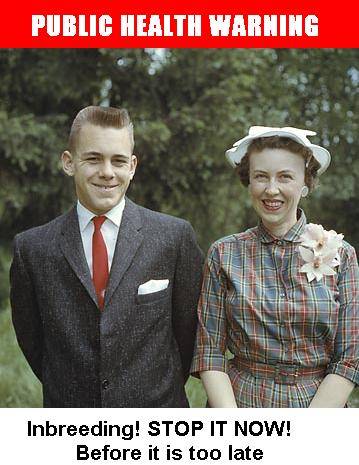INBREEDING:... is the breeding together of closely related plants or animals, for example mother/son, father/daughter and sibling/sibling crossings. For breeders, it is a useful way of fixing traits into a strain, breed or variety.
Inbreeding does hold some potential problems.
The limited gene pool caused by continued inbreeding means that deleterious or harmful genes become widespread and the breed then loses its vigour.
Laboratory animal suppliers depend on this to create very uniform strains of animals which are immuno-depressed or breed true for one particular disorder or another, for example: epilepsy for testing drugs for epilepsy.....
Such animals are so inbred as to be genetically identical (virtually clones!), a situation normally only seen in identical twins. Similarly, a controlled amount of inbreeding can be used to fix desirable traits in farm livestock and plants, for example: milk yields and in cannabis, density of buds, buds to leaf ratios, rate of growth, colour, flavour etc.
...and on to..:Natural Occurrence of Inbreeding......
A wolf pack, which is totally isolated from other wolf packs, by geographical or other factors, can become very inbred.....Also so can be said of cannabis varieties isolated in remote locations up in the hills and valley's around the world that are inbred successively over many generations to create what is know as a 'Land-Race' variety or strain as say in the Parvati Valley in India with many varieties/strains named after their location of cultivation...(the village name)...
.....LANDRACE: refers to a race of animals or plants ideally suited for the land (environment) in which they live and, in some cases, work; they often develop naturally with minimal assistance or guidance from humans (or from humans using traditional rather than modern breeding methods), hence are usually older, less modern races.
....The effect of any harmful or undesirable genes becomes noticeable in later generations.... as the majority of the offspring inherit these genes....
Scientists have discovered that Wolves, even if living in different areas, are genetically very...very similar. Quite obviously the gradual and relentless desolation of their natural habitat has drastically reduced wolf numbers in the past creating a definite genetic bottleneck.
...Let's look at the Wolf....:the lack of genetic diversity makes them susceptible to disease... since they lack the ability to resist certain viruses.
Extreme inbreeding affects their reproductive success with small litter sizes and high mortality rates.....Some scientists hope that they can developed a much more varied gene pool by introducing Wolves from other areas into the inbred Wolf Packs....
Inbreeding does hold some potential problems.
The limited gene pool caused by continued inbreeding means that deleterious or harmful genes become widespread and the breed then loses its vigour.
Laboratory animal suppliers depend on this to create very uniform strains of animals which are immuno-depressed or breed true for one particular disorder or another, for example: epilepsy for testing drugs for epilepsy.....
Such animals are so inbred as to be genetically identical (virtually clones!), a situation normally only seen in identical twins. Similarly, a controlled amount of inbreeding can be used to fix desirable traits in farm livestock and plants, for example: milk yields and in cannabis, density of buds, buds to leaf ratios, rate of growth, colour, flavour etc.
...and on to..:Natural Occurrence of Inbreeding......
A wolf pack, which is totally isolated from other wolf packs, by geographical or other factors, can become very inbred.....Also so can be said of cannabis varieties isolated in remote locations up in the hills and valley's around the world that are inbred successively over many generations to create what is know as a 'Land-Race' variety or strain as say in the Parvati Valley in India with many varieties/strains named after their location of cultivation...(the village name)...
.....LANDRACE: refers to a race of animals or plants ideally suited for the land (environment) in which they live and, in some cases, work; they often develop naturally with minimal assistance or guidance from humans (or from humans using traditional rather than modern breeding methods), hence are usually older, less modern races.
....The effect of any harmful or undesirable genes becomes noticeable in later generations.... as the majority of the offspring inherit these genes....
Scientists have discovered that Wolves, even if living in different areas, are genetically very...very similar. Quite obviously the gradual and relentless desolation of their natural habitat has drastically reduced wolf numbers in the past creating a definite genetic bottleneck.
...Let's look at the Wolf....:the lack of genetic diversity makes them susceptible to disease... since they lack the ability to resist certain viruses.
Extreme inbreeding affects their reproductive success with small litter sizes and high mortality rates.....Some scientists hope that they can developed a much more varied gene pool by introducing Wolves from other areas into the inbred Wolf Packs....











